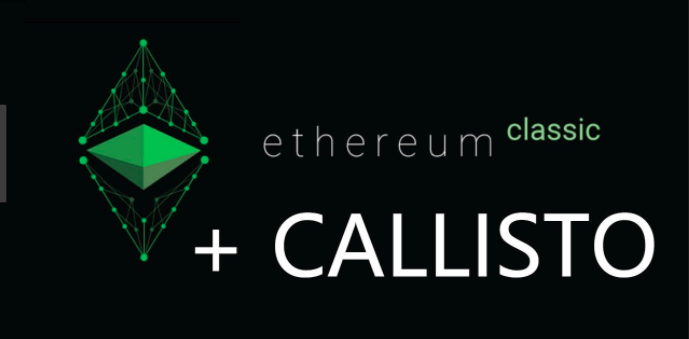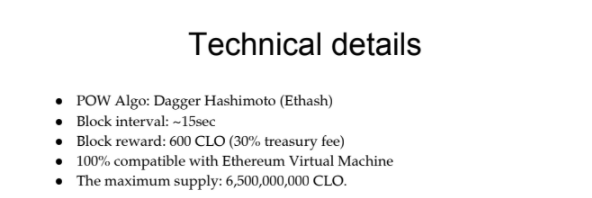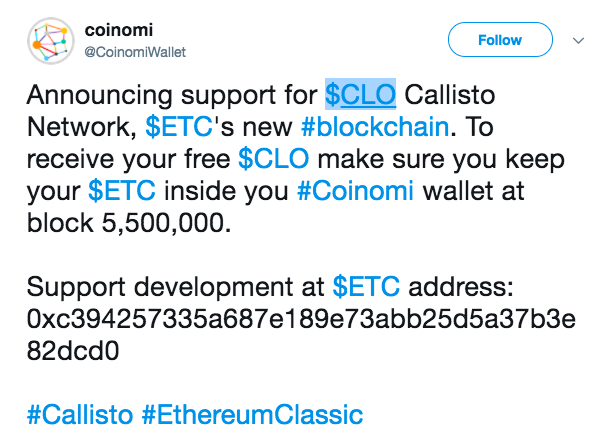Big changes are afoot in the Ethereum Classic camp. For investors, supporters, and sympathizers of this somewhat underdog community, the announcement of Callisto Network is big news. Named after one of Jupiter’s moons, Callisto is a sidechain that primarily aims to help ETC scale and introduce a “cold staking” protocol.
Callisto will be a separate blockchain that integrates with the ETC mainchain, and it will have its own native CLO token. Callisto will have a fixed cap monetary policy (similar to ETC) and incentives designed to make users to treat CLO as a store of value. All of this has been met with a lot excitement as it has the potential to vault ETC to previously unattained levels.
In the following article, we’ll outline the most important details from the Callisto white paper, discuss the airdrop, and speculate about what this may mean for the future of ETC as a whole.
What is the Callisto Network?

Callisto Network is a decentralized, open-source crypto platform based on go-Ethereum source code with its own cryptocurrency (CLO). Introduced by u/Dexeran, the leader of the Ethereum Commonwealth (one of ETC’s 3 development teams), the goal of Callisto is simple: boost the growth and adoption of Ethereum Classic as a community and as a platform.
Mislabeled by some as a hard fork of the ETC chain, Callisto will be a parallel or sidechain that is intended to bring a number of benefits.
Scaling
A big focus of the project is scaling. Just like any other cryptocurrency, ETC has issues with scalability. Bitcoin was the first canary in the scaling coal mine, and we all know how that turned out (transaction fees and confirmations times have become essentially insurmountable in recent months). ETC devs are tackling this issue via sidechain as opposed to keeping things “on chain” with bigger blocks (like Bitcoin Cash).
For the uninitiated, a sidechain is “a separate blockchain that is attached to the parent through the use of a two-way peg which allows for assets to be interchangeable and moved across the chain at a fixed deterministic exchange rate.” In simplified terms, this means that sidechains carry their own data sets/functionality which is tied into the parent chain. Using a sidechain frees up bandwidth on the main ETC chain.
This sidechain will be used as a way to research and provide a reference implementation of future protocol changes. Said another way, CLO will serve as a sort of testnet for ETC (but with monetary value).
To paraphrase The Merkle: Callisto will help improve the scalability of both Ethereum Classic and this new network, as well as implement cross-chain service improvements.
If all goes according to plan, it will be possible to use Callisto smart contracts on the ETC chain and vice versa. This is potentially groundbreaking stuff, but a lot of work remains to be done.
Cold Staking
Another problem ETC has faced is that there is no incentive mechanism for holders to retain their coins, a critical feature for a store-of-value token. The introduction of Callisto is a way for ETC to experiment with the “cold staking protocol” which addresses this shortcoming by rewarding holders for being part of the network.
What exactly is cold staking? Cold staking is a smart contract-based process that allows CLO holders to earn interest in a total CLO emission when they hold CLO coin balances for a long enough period time.
Let’s break it down: Anyone who holds CLO can become a cold staker. All that’s required for this to happen is to lock some funds into a treasury smart contract (written in Solidity and deployed on the network) for a minimum period of one month.
Although a PoW system remains in place, there is no need for stakers to run a node or solve any problems. Each cold staker can participate in the governance of the blockchain by submitting proposals and voting on existing proposals.
CLO cold stakers are rewarded for being part of the network governance model through a reward from the treasury. The treasury balance is a 10% fee from each Callisto block. The reward amount is dependent on the number of stakers at a given time (the more stakers, the less the reward).
Cold staking is designed to incentivize holders to hang onto their CLO for an extended period of time, thus increasing its “store of value” status mentioned above. Whether or not cold staking will catch on remains to be seen. However, it’s a bold step toward an automated future where governance is carried out on chain, and it’s undeniably positive to see developers looking for creative solutions to existing problems.
Other Notable Features
There is often a lack of tools to make Ethereum smart contracts secure. Smart contract hacks is a big issue and costs the ecosystem significant amounts of money. Callisto will create an official smart contract auditing department to protect both the ETC and CLO ecosystems. This is a completely free professional smart contract auditing opportunity for end-users.
Every blockchain evolves, and sometimes the hard fork process can be fractious, stressful,and disorganized. Another feature worth mentioning is Callisto’s solution to this issue. Callisto is predefining upgrade dates so that all members of the community will know about changes well in advance and can be prepared for them. Planned hard fork dates are November 11, 2018 and May 5, 2019.
A few other key technical details of the network are:

The Callisto roadmap for 2018 is an aggressive one, with the following goals targeted:
- Launch of testnet 2.0
- Creation of a marketing team
- Launch of a mobile wallet app
- Rollout of planned hard fork #1, with implementation of cold staking
CLO Initial Distribution
When the genesis block of Callisto is mined, every holder of ETC will be allocated CLO at a ratio of 1:1.
When will this occur? According to a January Commonwealth dev update:
A snapshot will be taken of the ETC blockchain at block 5500000 (approximately 5 March, 2018. This depends on ETC block time and ETC hashrate changes).
What does an existing ETC holder need to do to make sure they get their CLO? Wait.
If you’re holding ETC, you will automatically receive CLO at the moment of the Callisto mainnet launch.
But what happens if your ETC is on an exchange at the time of the airdrop? In this scenario, what will happen is less clear. Technically, every exchange with ETC on the books will receive CLO; but if they decide not to support it, users may not be properly credited.
Many have asked if cryptocurrency exchanges like Binance or Bittrex will support CLO. At the time of writing, there is no official word but there will reportedly be a published list of supported exchanges. If in doubt, be sure to move your ETC to a supported wallet or contact technical support at your exchange.
The next question many people ask is: which wallets will support CLO? According to Dexaran:
we are working with ClassicEtherWallet and ClassicMask chrome extension.
A good note for beginners: it can be easy to forget that wallets are just tools for interacting the blockchain and you’re not actually storing ETC tokens there. You may have a balance in your wallet but this is just a reflection of what’s on the blockchain.
Every address on the ETC chain will be airdropped CLO; so if you’re using a wallet that does not support it, your issue would be access and not necessarily missing out on the tokens. If you retain custody of your private key, you will be able to control your CLO.
To again quote Dexaran:
Everything that is supporting ETC or ETH will automatically support CLO since address derivation and transaction signing algorithms are exactly the same.
Beyond ClassicEtherWallet and ClassicMask, news like this has been popping up lately (more is expected to follow):

Final Thoughts
As the airdrop approaches, hype for the Callisto project is growing as is the chatter on Reddit and Discord. But it’s worth remembering that many of the ideas, plans and features discussed in this article are still a long way from fruition.
With that caveat in place, Callisto is an intriguing project that more people should be paying attention to.
For more information, you can read the Callisto FAQ or dive into the conversation on Discord. And for the more technically-minded, you can track progress on Github or read the whitepaper for yourself.

